Profiled sheet is a popular material for roofing, wall cladding and fences. However, it belongs to thin-sheet materials. This means that the flooring should be attached to different surfaces and structures in different ways.
- Types of fasteners
- Features of fasteners for profiled sheet
- Head device
- Dimensions and consumption of screws
- Determination of the number of fasteners per sheet
- Influence of roof slope on installation
- How to properly fix a professional sheet
- Fastening the profiled sheet with self-tapping screws
- Riveting
- Tips from builders
Types of fasteners
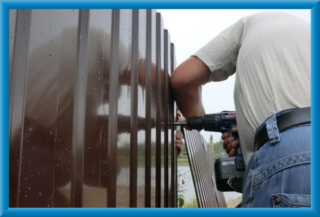
Fastening the profiled sheet to metal purlins is performed in several ways.
Most often, fixation is performed using self-tapping screws. In this case, you do not need to pre-drill the holes. The tip of the self-tapping screw is sharpened and, when connected, acts as a mini-drill. They make a variety of self-tapping screws, including galvanized ones, which are more suitable for profiled sheet flooring. You can fix it with self-tapping screws without special tools. In addition, dismantling is possible without damaging the sheet.
Rivets are less common, since a hole must be drilled when riveting. As a result, the method turns out to be very laborious. Rivets are taken when fixing on hollow pipes and corners. In this case, deepening into the material does not give additional strength, but riveting ensures the reliability of the docking.
Dismantling the structure on rivets is difficult and almost always leads to damage to the corrugated board.
For fastening the profiled sheet to metal purlins, galvanized self-tapping carbon steel screws are used. According to GOST, the zinc layer is from 12.5 to 25 microns.
Features of fasteners for profiled sheet
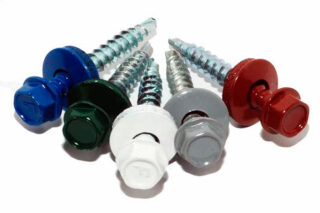
The self-tapping screw must pierce the steel strip and sheet. For this, only a special product made of carbon steel grade C1022 is suitable. The thread pitch of such a self-tapping screw is small, the tip is pointed, but less than in a self-tapping screw for wood. It can punch through metal up to 2.5mm without drilling.
The self-tapping screw for wood passes through a sheet up to 1.2 mm thick.
Hardware has other features.
- The self-tapping screw is resistant to pulling out, twisting and tearing.
- The special model is supplied with an EDRM rubber head washer. The gasket protects the fixing point from water. Material - modernized synthetic rubber, when in contact with metal, vulcanizes, therefore, even after a long period of time, the gasket does not lose its elasticity and neutralizes thermal deformation.
- There is a protrusion on the edge of the hex washer. He presses the press washer against the overlap. This does not damage the flooring.
Self-tapping screws come on sale with a colored coating. The range of shades corresponds to the RAL line. Choosing the right color for fasteners is easy.
Head device
Hardware with a sharp end does not drill, but breaks through metal. Fasteners will require more force, which usually results in material damage. A conventional screwdriver without a sealing washer is also not suitable: with rigid fixation, the ability to compensate for the thermal expansion of the material disappears, the roof warps and cracks.
To fasten the corrugated board to metal rails and beams, use hexagonal self-tapping screws with a drill at the end. This option drills through the sheet and does not require much effort.
Dimensions and consumption of screws
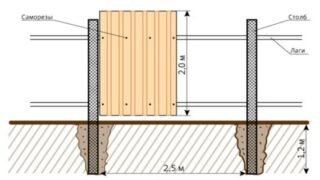
The dimensions of the hardware depend on the future load. It is advised to select a self-tapping screw according to this rule: the length of the screw is greater than the total thickness of the elements to be fastened.
The products are available in the following sizes.
- The length of the hardware ranges from 1.9 to 2.5 cm.
- The diameter varies from 4.8 to 6.3 mm. The thicker the coating layer, the larger the cross-section of the hardware.
The weight of the screws is determined by the diameter and thread. 100 pieces. hardware with a diameter of 5.5 mm and 1.5 cm in length weighs 18.5 kg. Such calculations are required, since fasteners are sold by weight, and the builder needs to know the number of hardware.
Determination of the number of fasteners per sheet
The number of fixation points depends on the load. When installing the profiled sheet on the ridge, the number of fasteners doubles compared to fixing the flooring on the logs. As a standard, 6-9 self-tapping screws are used to fix 1 sheet.
When calculating, you need to be guided by the recommendations of manufacturers. This is important not only for reliability. If the provisions prescribed in the instructions are not followed during installation, in the event of an accident and damage, the manufacturer will not accept claims from the builder or owner of the building.
Influence of roof slope on installation
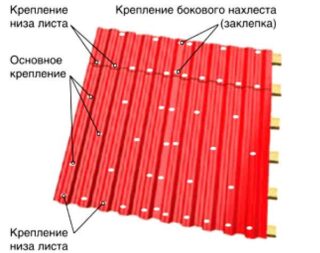
The angle of inclination of the slope does not affect the way of laying. In this case, the hardware is used the same, but the overlap has to be done differently. Otherwise, leakage is possible.
The recommendations are as follows:
- at an angle of less than 12 degrees, the material is laid with an overlap of at least 20 cm and the joints are additionally sealed;
- if the angle increases to 14 degrees, the overlap reaches 20 cm;
- with a slope of 15-30 degrees, the overlap is reduced to 15 cm;
- more than 30 degrees decreases to 10 cm.
When laying at a low angle, thicker sheets should be used. The fastening of the corrugated board is performed with hardware with a large diameter.
How to properly fix a professional sheet
The mounting technology when using self-tapping screws and rivets is different. The first option is easier to do it yourself.
Fastening the profiled sheet with self-tapping screws
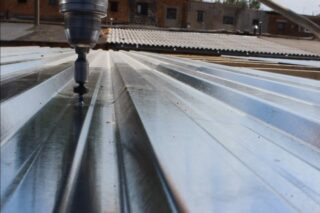
Self-tapping screws are supplied with instructions. Following the step by step guide will make it easier to assemble the roof.
- The profiled sheet, like a flat sheet, is laid with an overlap. The amount of overlap depends on the type of surface and the angle of inclination. A wave is superimposed on a wave.
- It is recommended to fasten it between the waves, and not on the crest. This requires a shorter hardware. The sheet is fixed to the comb only on the ridge.
- Screw the hardware with a screwdriver. A drill without a regulator is not suitable, since screwing in is performed at a speed of no more than 1500 rpm.
- The self-tapping screw should enter the sheet at an angle of 90 degrees, regardless of the slope of the slope. The fastening step is selected according to the manufacturer's recommendations. Usually, when installing a ceiling on a steel profile, the distance is 50 cm.
Drilling is performed only if the thickness of the metal profile is more than 2 mm.
Riveting
Such work requires a construction hand gun. In the profiled sheet, you need to pre-drill holes for each fixation point. The rivets are selected according to the weight of the sheet and the thickness of the profile.
The installation scheme, according to SNiP, is the same. The sheets are mounted with an overlap, the fastening step is determined by the expected load. Riveting will be performed on one side at the place of fixation.
Tips from builders
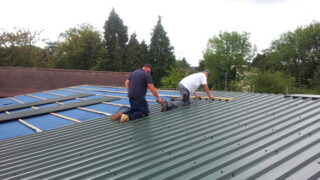
It is quite simple to attach the profiled sheet to a wooden or metal frame. To achieve reliable fixation, it is advised not to forget the following.
- You need to sensibly assess the load. Determine the weight of the profiled sheet, the slope, if the installation is carried out on the roof, wind and snow load.
- When mounting on complex structures - the ridge of the roof, the number of fixation points is increased.
- It is better to install the flooring together: one worker holds the sheet at the level, the second screw in a self-tapping screw with a screwdriver.
- After fixing at 1-2 points, check the horizontal position of the fastening, and only then screw in the next self-tapping screw.
For the installation of profiled sheets on an iron frame, only special fasteners are used - self-tapping screws made of galvanized alloy steel with a drill tip. The dimensions and diameter of the fastener are calculated from the weight of the sheet and the characteristics of the structure.









